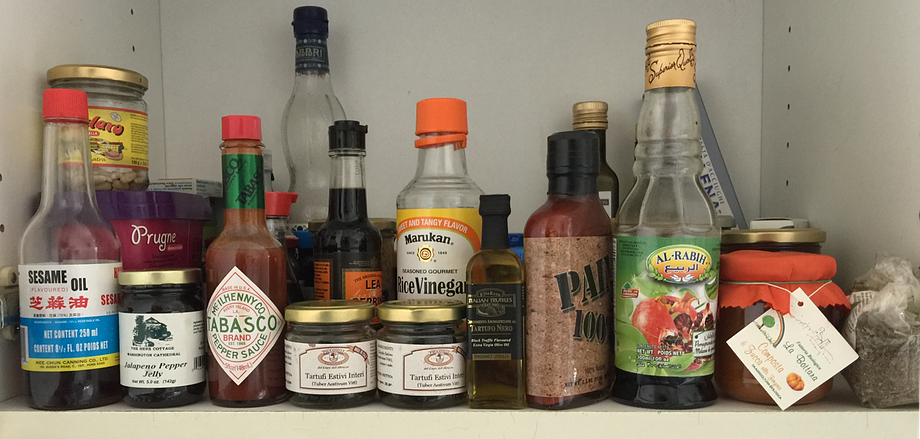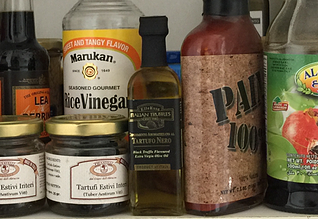An old friend sent me a cutting of a column in The (London) Times magazine, exploring the contents of Food Editor Tony Turnbull’s larder. I’d like to take credit for inspiring this, the very week of my podcast on the same topic, but I know how magazine journalism works and the piece was probably rustled up long ago.
Eat This Newsletter 008 Gleanings
27 July 2015
Real finger food for digital appetites
- The oldest bread in England has been unearthed. How long before someone bakes a replica?
- Smithonian magazine explains how much we owe pimps. See the love apple in a whole new light.
- Immigrants grow exotic crops, local neighbourhood rejoices, this time in St Louis. I officially declare this a trope.
- A great writer reviews what sounds like a great anthology: Pleasures of the Literary Meal by Bee Wilson, on Christina Hardyment’s Pleasures of the Table: A Literary Anthology.
- And speaking of great writers, I’ve pledged to enable Jonathan Meades to produce The Plagiarist in the Kitchen, and you can too.
Larder inessentials What’s lurking at the back of my fridge and cupboards

Podcast: Play in new window | Download (Duration: 20:47 — 14.7MB)
Subscribe: Google Podcasts | Spotify | Android | RSS | More
 The heat here in Rome has been something the past couple of weeks. Not up to 2003 of blessed memory, but hot nevertheless. The last thing I needed was for the fridge to start playing up, but it did, making horrible noises. Ignoring the disaster foretold, I defrosted the darn thing, which not only solved the problem (temporarily) but also provided inspiration for this episode of Eat This Podcast. At the back of the fridge I found things I had completely forgotten. That prompted me to dig around in the back of the store cupboard too, where there were lots of other things of which I was vaguely aware, but not aware enough actually to have used them. All of which prompted a musing on store-cupboard essentials, gifts from well-meaning friends, and the whole neophilia-neophobia tension. I hope I didn’t ramble on for too long.
The heat here in Rome has been something the past couple of weeks. Not up to 2003 of blessed memory, but hot nevertheless. The last thing I needed was for the fridge to start playing up, but it did, making horrible noises. Ignoring the disaster foretold, I defrosted the darn thing, which not only solved the problem (temporarily) but also provided inspiration for this episode of Eat This Podcast. At the back of the fridge I found things I had completely forgotten. That prompted me to dig around in the back of the store cupboard too, where there were lots of other things of which I was vaguely aware, but not aware enough actually to have used them. All of which prompted a musing on store-cupboard essentials, gifts from well-meaning friends, and the whole neophilia-neophobia tension. I hope I didn’t ramble on for too long.
Some the things that did not make it into my rambles:
- The whole business of gleaning that gave rise to grano arso I find fascinating. Gleaners were surely the first dumpster divers. The practice is enshrined in the Old Testament and I like the idea that richer landowners sometimes deliberately left fruit behind in their vineyards and orchards and grain in their fields that the poor might gain. I am not competent to say anything more about Ruth than that I find her’s a very moving story.
- The other story behind grano arso is that it was not the stubble-cleansing fires that burnt the gleaned wheat grains but rather the heat from steam-powered threshing machines. Probably both. I don’t know whether any Pugliese who remembers the old stuff would agree that smoked or oven-burnt flour is in any way a substitute, but I like it.
- Here’s a recent entry point to my adventures with grano arso.
- I do feel rather ashamed about the garum thing. After my podcast Lauren Stacy Berdy was so kind to send me a bottle of her American garum and I still haven’t tried it. But I will, and soon, I promise. And perhaps I’ll report back here.
Eat This Newsletter 007 Gleanings
13 July 2015
Help yourself. There’s plenty more inside.
- Here’s something bizarre: a chef celebrated for his cooking.
- How India’s leadership promotes malnutrition and stunting. I wonder whether this new nutrition thing has a solution.
- Extra helpings of food price data, stunningly visualized
- You know David Simon, the man who wrote The Wire. But do you know what he remembers about food and his family?
- This one’s been around, and not surprisingly. The fabled flatbreads of Uzbekistan
- Bonus shameless self-promotion. They’ve found citrus greening disease in California. For a glimpse at what looking for plant pests entails, listen to this episode of Eat This Podcast.
Culture and agriculture in the Pamirs With our own hands: a new book

Podcast: Play in new window | Download (Duration: 26:38 — 18.6MB)
Subscribe: Google Podcasts | Spotify | Android | RSS | More
 The Pamir Mountains of Central Asia hold a fascinating diversity of food crops. Exploring the area in the early years of the 20th century the great Russian botanist Nikolai Vavilov became convinced that this was where “the original evolution of many cultivated plants took place.” Soft club wheat, with its short ears, rye, barley, oil plants, grain legumes like chick peas and lentils, melons and many fruits and vegetables; all showed the kind of diversity that Vavilov said pointed to the places where they were first domesticated. As he wrote, “it is still possible to observe the almost imperceptible transition from wild to cultivated forms within the area.”
The Pamir Mountains of Central Asia hold a fascinating diversity of food crops. Exploring the area in the early years of the 20th century the great Russian botanist Nikolai Vavilov became convinced that this was where “the original evolution of many cultivated plants took place.” Soft club wheat, with its short ears, rye, barley, oil plants, grain legumes like chick peas and lentils, melons and many fruits and vegetables; all showed the kind of diversity that Vavilov said pointed to the places where they were first domesticated. As he wrote, “it is still possible to observe the almost imperceptible transition from wild to cultivated forms within the area.”
Frederik van Oudenhoven first travelled to the Pamirs in 2007 to document what remained of that rich agricultural biodiversity. What he found was bewildering, until he began to talk to Pamiri people, and especially the older women, about their food and culture. The result is With Our Own Hands: a celebration of food and life in the Pamir Mountains of Tajikistan and Afghanistan, a new book by van Oudenhoven and his co-author Jamila Haider, that documents a culture that remains in danger of disappearing.
Notes
- With Our Own Hands is published by LM Publishers, who say it will be available from tomorrow, 7 July. If you think you might want a copy, order without delay; until tomorrow the price is reduced to €34.50 from €54.50. You can get a taste here.
- There are also a couple of scholarly articles online. Imagining alternative futures through the lens of food in the Afghan and Tajik Pamir mountains and Food as a method in development practice.
- Photos by Frederik van Oudenhoven. The banner shows an Afghan settlement in Darvaz, along the Panj River, in autumn, with yellow mulberrry trees and red apricots. the other picture is Frederik and his co-author Jamila Haider.